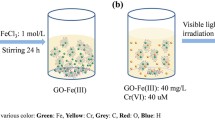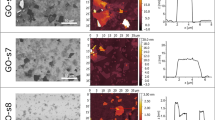Abstract
The photoreactivity of graphene oxide (GO) suspensions was investigated with a double aim: (i) to give insights into the previously reported photo-reduction process, which allows a partial elimination of the oxygen-containing groups from the 2D graphitic structure; (ii) to explore the possible use of GO as photo-activator able to promote the photo-transformation/abatement of organic molecules. To reach these goals and clarify some peculiar aspects of the photochemistry of GO till now obscure or confuse, we synthesized and characterized stable GO suspensions which were then subjected to UV–Vis irradiation for prolonged times. GO underwent partial photo-reduction with the release of gaseous molecules and soluble organic species (e.g., carboxylic acid). The mechanisms of photo-reduction occurring under air or N2 are different, as assessed by the release in solution of diverse soluble molecules. In the presence of oxygen, at long irradiation time, a complete solubilization of the graphenic structures was observed. No difference in the nature and amount of released gases (principally CO2 and CO) was observed in the oxic or anoxic conditions. The possible use of GO as photo-activator was evaluated using phenol as probe molecule. GO revealed a double role of photo-activator and reagent in phenol degradation, as competition was assessed between GO self-transformation/reduction and phenol degradation. At prolonged irradiation time, a marked reactivity of the photoformed species was observed and the complete degradation was achieved for both organic small molecules formed from GO and the phenol added as probe molecule.










Similar content being viewed by others
References
Brodie BC (1859) On the atomic weight of graphite. Philos Trans R Soc 149:249–259
Staudenmaier L (1898) Method of preparation of graphite-acid. Berichte der Deutschen Chemishen Gesellschaft 31:1481–1499
Hummers WS, Offeman RE (1958) Preparation of graphitic oxide. J Am Chem Soc 80:1339
Wang Y, Chen X, Zhong Y, Zhu F, Loh KP, Dreyer DR, Park S, Bielawski CW, Ruoff RS (2010) The chemistry of graphene oxide. Chem Soc Rev 39:228–240
Compton OC, Binh S, Nguyen T (2010) Graphene oxide, highly reduced graphene oxide, and graphene: versatile building blocks for carbon-based materials. Small 6:711–723
Krishnamoorthy K, Veerapandian M, Yun K, Kim SJ (2013) The chemical and structural analysis of graphene oxide with different degrees of oxidation. Carbon 53:38–49
Mathkar A, Tozier D, Cox P, Ong P, Galande C, Balakrishnan K, Leela A, Ajayan P (2012) Controlled, stepwise reduction and band gap manipulation of graphene oxide. J Phys Chem Lett 3:986–990
Williams G, Seger B, Kamat PV (2008) TiO2-graphene nanocomposites. UV-assisted photocatalytic reduction of graphene oxide. ACS Nano 2:1487–1491
MdSAS Shah, Park AR, Zhang K, Park JH, Yoo PJ (2012) Green synthesis of biphasic tio2-reduced graphene oxide nanocomposites with highly enhanced photocatalytic activity. ACS Appl Mater Interfaces 4:3893–3900
Stengl V, Popelkova D, Vlacil P (2011) TiO2-graphene nanocomposite as high performace photocatalysts. J Phys Chem C 115:25209–25219
Du J, Lai X, Yang N, Zhai J, Kisailus D, Su F, Wang D, Jiang L (2011) Hierarchically ordered macro–mesoporous TiO2–graphene composite films: improved mass transfer, reduced charge recombination, and their enhanced photocatalytic activities. ACS Nano 5:590–596
Long M, Qin Y, Chen C, Guo X, Tan B, Cai W (2013) Origin of visible light photoactivity of reduced graphene oxide/TiO2 by in situ hydrothermal growth of undergrown tio2 with graphene oxide. J Phys Chem C 117:16734–16741
Jiang B, Tian C, Zhou W, Wang J, **e Y, Pan Q, Ren Z, Dong Y, Fu D, Han J, Fu H (2011) In situ growth of TiO2 in interlayers of expanded graphite for the fabrication of TiO2-graphene with enhanced photocatalytic activity. Chem Eur J 17:8379–8387
Sun L, Zhao Z, Zhou Y, Liu L (2012) Anatase TiO2 nanocrystals with exposed 001 facets on graphene sheets via molecular grafting for enhanced photocatalytic activity. Nanoscale 4:613–620
Huang NM, Lim HN, Chia CH, Yarmo MA, Muhamad MR (2011) Simple room-temperature preparation of high-yield large-area graphene oxide. Int J Nanomed 6:3443–3448
Mei Q, Zhang K, Guan G, Liu B, Wang S, Zhang Z (2010) Highly efficient photoluminescent graphene oxide with tunable surface properties. Chem Commun 46:7319–7321
Li D, Mueller MB, Gilje S, Kaner RB, Wallace GG (2008) Processable aqueous dispersions of graphene nanosheets. Nat Nanotechnol 3:101–105
Marcano DC, Kosynkin DV, Berlin JM, Sinitskii A, Sun Z, Slesarev A, Alemany LB, Lu W, Tour JM (2010) Improved synthesis of graphene oxide. ACS Nano 4:4806–4814
Gao X, Jang J, Nagase S (2010) Hydrazine and thermal reduction of graphene oxide: reaction mechanisms, product structures, and reaction design. J Phys Chem C 114:832–842
Shang JI, Ma L, Li J, Ai W, Yu T, Gurzadyan G (2012) The origin of fluorescence from graphene oxide. Sci Rep 2:1–8
Galande C, Mohite AD, Naumov AV, Gao W, Ci L, Ajayan A, Gao H, Srivastava A, Weisman RB, Ajayan PM (2011) Quasi-molecular fluorescence from graphene oxide. Sci Rep 85:1–5
Li J-L, Tang B, Yuan B, Sun L, Wang X-G (2013) A review of optical imaging and therapy using nanosized graphene and graphene oxide. Biomaterials 34:9519–9534
Cao L, Meziani MJ, Sahu S, Sun YP (2012) Photoluminescence properties of graphene versus other carbon nanomaterials. Acc Chem Res 46:171–180
Park J, Lee WH, Huh S, Sim SH, Kim SB, Cho K, Hong BH, Kim KS (2011) Work-function engineering of graphene electrodes by self-assembled monolayers for high-performance organic field-effect transistors. J Phys Chem Lett 2:841–845
Park J, Jo SB, Yu YJ, Kim Y, Yang JW, Lee WH, Kim HH, Hong BH, Kim P, Cho K, Kim KS (2012) Single-gate bandgap opening of bilayer graphene by dual molecular do**. Adv Mater 24:407–411
Guardia L, Villar-Rodil S, Paredes JI, Rozada R, Martınez-Alonso A, Tascón JMD (2012) UV light exposure of aqueous graphene oxide suspensions to promote their direct reduction, formation of graphene–metal nanoparticle hybrids and dye degradation. Carbon 50:1014–1024
Fernández-Merino MJ, Guardia L, Paredes JI, Villar-Rodil S, Solís-Fernández P, Martínez-Alonso A, Tascón JM (2010) Vitamin C is an ideal substitute for hydrazine in the reduction of graphene oxide suspensions. J Phys Chem C 114:6426–6432
Shulga YM, Martynenko VM, Muradyan VE, Baskakov SA, Smirnov VA, Gutsevl GL (2010) Gaseous products of thermo- and photo-reduction of graphite oxide. Chem Phys Lett 498:287–291
Coble PG (1996) Characterization of marine and terrestrial DOM in seawater using excitation-emission matrix spectroscopy. Mar Chem 51:325–346
Plotnikov VG, Smirnov VA, Alfimov MV, Shul’ga YM (2011) The graphite oxide photoreduction mechanism. High Energy Chem 45:411–415
Sangermano M, Calza P, Lopez-Manchado MA (2013) Graphene oxide-epoxy hybrid material as innovative photocatalyst. J Mater Sci 48:5204–5208
Minero C, Vione D (2006) A quantitative evaluation of the photocatalytic performance of TiO2 slurries. Appl Catal B-Environ 67:257–269
Acknowledgements
This research is supported by a Marie Curie International Research Staff Exchange Scheme Fellowship (PHOTOMAT, proposal n. 318899) within the 7th European Community Framework Programme. MM and MD are grateful to Dr. Chiara Deiana for her help during the ATR-FTIR measures.
Author information
Authors and Affiliations
Corresponding author
Electronic supplementary material
Below is the link to the electronic supplementary material.
Rights and permissions
About this article
Cite this article
Minella, M., Demontis, M., Sarro, M. et al. Photochemical stability and reactivity of graphene oxide. J Mater Sci 50, 2399–2409 (2015). https://doi.org/10.1007/s10853-014-8791-1
Received:
Accepted:
Published:
Issue Date:
DOI: https://doi.org/10.1007/s10853-014-8791-1




